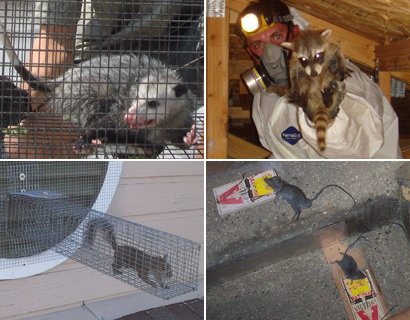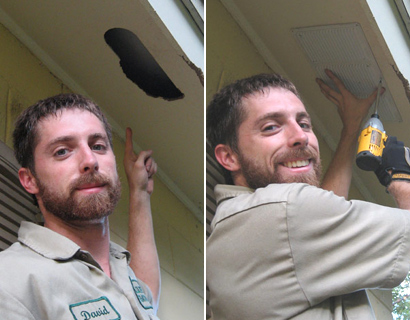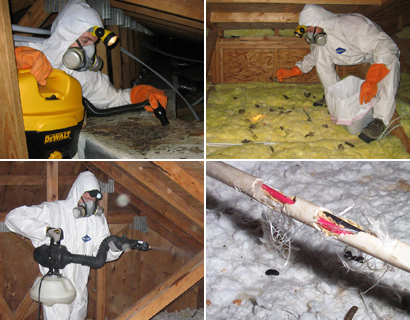- How We Solve Missouri Wildlife Problems
How We Solve Saint Louis Wildlife Problems
INSPECTION: Once on site, we will perform a full inspection of your home and property. This allows us to use the correct strategy and traps. If the animals are in an attic, a full building inspection is crucial, including the following:
- All ground-level areas, such as piper or A/C line entry & exit areas, A/C chase bottoms, ground-level vents, etc.
- All mid-level areas, such as dryer vents, siding gaps, first floor eaves or dormers, etc.
- We inspect the entire roof, including all plumbing stacks, ridge caps, vents, and other potential gaps or holes.
- We also inspect inside your attic, to identify animals and damage they have caused.
- If the animals are outside, we notice many subtle clues that will assist us in a successful strategy.
TRAPPING, EXCLUSION, REMOVAL: Once we understand what animal species we are dealing with, and the problem, we use the most effective means of removing the animals. We use dozens of different types of traps.
- Trapping - If trapping the animal(s) in live cage traps, trap type, set, and location are crucial to success.
- Exclusion - Oftentimes, we are able to simply set one-way doors or other exclusion devices that allow the animals inside a building to safely exit, but never get back inside.
- Removal By Hand - Sometimes we actually remove animals by hand, or with special tools like snare poles.
- The Law - In all cases, we obey state and local laws regarding wildlife, but aim to take the most humane approach.
ENTRY HOLE REPAIRS: Repairs are a crucial step in the wildlife removal process. In many cases, such as bat or rodent control, the job cannot be performed without detailed repairs, and in all cases, sealing the entry holes shut ensures that no future wildlife will ever enter your home.
- 100% of the entry holes must be found, and sealed shut, or the job is not complete.
- Our repairs are professional contractor grade, look good, and when applicable we use steel, which rodents such as rats or squirrels are unable to chew through.
- We give a written guarantee on our repairs against any future animal entry.
ATTIC DECONTAMINATION SERVICES: It may be desirable to clean your attic after we've removed the animals. They can leave behind large amounts of droppings, urine, hair, oils, food, nesting material, and so on. These remnants can attract insects like cockroaches, and the scent left behind can encourage new animals to chew their way into your house. You might experience odor problems from the waste. It's possible that mold will grow on waste areas.
- We remove or vacuum all droppings, or remove all the soiled insulation.
- We fog the attic with a special enzyme-based cleaner that destroys any organic matter and deodorizes the space.
- We repair damage, such as ductwork, electrical wires, pipes, insulation, and more.
Did you know your attic is the best place for Saint Louis wildlife such as birds and rodents? They can find their way in through smalls gaps and leave behind serious damage! Our company specializes in wildlife trapping, removal, and prevention. Give us a call so we can help keep your family and home safe. We service the following cities: Bel-Nor, Bel-Ridge, Bella Villa, Bellefontaine Neighbors, Bellerive, Berkeley, Beverley Hills, Black Jack, Breckenridge Hills, Brentwood, Bridgeton, Calverton Park, Champ, Charlack, Clarkson Valley, Clayton, Cool Valley, Country Club Hills, Crestwood, Country Life Acres, Creve Coeur, Crystal Lake Park, Dellwood, Des Peres, Edmundson, Eureka, Ferguson, Fenton, Flordell Hills, Florissant, Frontenac, Glen Echo Park, Glendale, Grantwood Village, Greendale, Green Park, Hanley Hills, Hazelwood, Hillsdale, Huntleigh, Kinloch, Kirkwood, Jennings, Ladue, Lakeshire, Mackenzie, Manchester, Maplewood, Marlborough, Maryland Heights, Mehlville, Moline Acres, Normandy, Northwoods, Norwood Court, Oakland, Olivette, Overland, Pacific, Pagedale, Pasadena Hills, Pasadena Park, Pine Lawn, Richmond Heights, Riverview, Rock Hill, St. Ann, St. John, Shrewsbury, Sunset Hills, Spanish Lake, Sycamore Hills, Town & Country, Twin Oaks, University City, Uplands Park, Valley Park, Velda City, Velda Village Hills, Vinita Park, Vinita Terrace, Warson Woods, Webster Groves, Wellston, Westwood, Wilbur Park, Wildwood, Winchester, Woodson Terrace, Affton, Ballwin, Chesterfield, and Ellisville. We also service the following counties: Adair County, Andrew County, Barry County, Barton County, Butler County, Caldwell County, Camden County, Carroll County, Dunklin County, Franklin County, Gasconade County, Gentry County, Greene County, Grundy County, Howell County, Iron County, Jackson County, Jasper County, Stone County, Sullivan County, Taney County, Texas County, Vernon County, Warren County, and Washington County.
Other Saint Louis animal pest control topics:
Do Mice Chew Wires
The Copperhead Snake
Do All Raccoons Have Rabies
Do I Need a Professional to Catch a Squirrel
To learn more about our services, visit the Saint Louis wildlife control home page.
This month's wildlife how-to article: The Coral Snake
The Coral Snake
Appearance
One of the most common species of coral snakes in the US have a red, yellow and black color combination. They are relatively small, slender snakes that are around 18 to 20 inches long but may indeed reach up to three feet in length! Their heads are bulbous in shape with round noses and almost identical looking tails - meaning, it's kind of hard to know which end is the tail and which is the head!
Biology
Coral snakes are divided even further into two very distinct groups:
• Old World coral snakes (Calliophis, Hemibungarus, Sinomicrurus with 16 species)
• New World coral snakes (Leptomicrurus, Micruroides and Micrurus with over 65 species!)
Coral snakes are venomous! In fact, they have the second most lethal venom of snakes (only the black mamba has a more lethal venom)! However, they are aren't considered as dangerous as rattlesnakes because they have a less effective way of delivering their poison into their victim.
Life Cycle
The life expectancy of a coral snake in the wild has been left unknown however, in captivity they usually live up to seven years. Coral snakes are not ovoviviparous which means that they are one of the very few venomous snakes that lay eggs. They will often lay around two to seven egs in the summer and expect to hatch sometime in the early fall. When born, young coral snakes have their distinctive bright red, yellow and black collors. They are also already fully venomous and can reach up to 7 inches long.
Habitat
In the US there are two types of coral snakes based on their location:
• Eastern Coral Snake
• Western Coral Snake
The eastern coral snake is considered the more common of the two however, they are both very rarely seen in the wild.
Both types prefer certain areas in the United States such as:
• Woods
• Marshes
• Other loose-soiled areas
Diet
As is with most snakes, coral snakes are carnivores.
They will eat:
• Other snakes (even other coral snakes)
• Reptiles (like lizards)
• Amphibians (such as frogs)
Behavior
These coral snakes are quite reclusive and prefer the safety of their burrows and dens located securely underground. However, once night falls, they will leave that relative safety in order to hunt and feed. Amongst themselves, coral snakes prefer being alone and even during mating will show some form aggression. When coral snakes feel threatened, they will sometimes produce a popping sound in order to startle it's would be attacker. It has been considered by most experts a form of aggressive-defensive behavior however, new speculations have said that it could also be a type of mating call.





